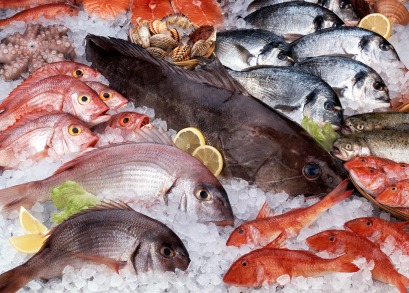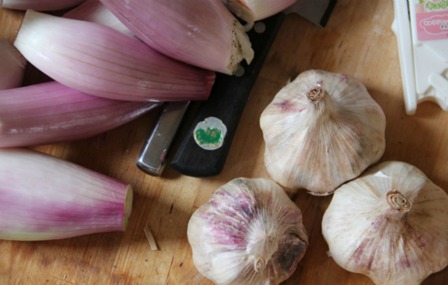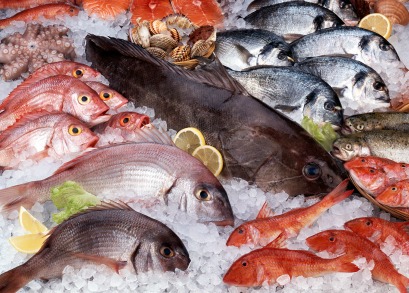 One fish, two fish, red fish, blue fish: They are all in trouble if global warming continues unabated.Stroll by any Whole Foods seafood counter and you will see color-coded fish: Green for fully sustainable, yellow for partially sustainable, and red for fish threatened by overfishing or grown on polluting fish farms. Buy a “green” fish and you eat guilt free, confident that you are doing your part to save the ocean and its inhabitants.
One fish, two fish, red fish, blue fish: They are all in trouble if global warming continues unabated.Stroll by any Whole Foods seafood counter and you will see color-coded fish: Green for fully sustainable, yellow for partially sustainable, and red for fish threatened by overfishing or grown on polluting fish farms. Buy a “green” fish and you eat guilt free, confident that you are doing your part to save the ocean and its inhabitants.
Put down your fork — Whole Foods is not telling you the whole story. The dirty little secret of their seafood rating system is that it ignores the largest and most imminent threat to our oceans: greenhouse-gas emissions. Even if every human on the planet miraculously decided to buy only seafood stamped with the Whole Foods seal of “sustainablity,” marine species will still be doomed.
This is not a secret threat: Just last month, the International Program on the State of the Ocean (IPSO) — a consortium of 27 of the top ocean experts in the world — declared that effects of climate change, ocean acidification, and oxygen depletion have already triggered a “phase of extinction of marine species unprecedented in human history.” According to Dr. Alex Rogers, director of the IPSO [PDF]:
The findings are shocking. As we considered the cumulative effect of what humankind does to the ocean the implications became far worse than we had individually realized … We are looking at consequences for humankind that will impact in our lifetime.
Sadly, in the era of climate crisis, overfishing and other forms of unsustainable harvest are the least of our problems. Rising carbon emissions are radically changing the chemical composition of our seas, having already contributed to the destruction of more than 85 percent of the world’s coral and oyster reefs. Rising air temperatures are changing wind patterns, which is a major cause of more than 400 ocean “dead zones” devoid of oxygen and sea life. Species ranging from gray whales to plankton are fleeing their native habitats for the first time in nearly 2 million years as water temperatures rise.
In other words, while some marine species are threatened by overfishing, our entire ocean ecosystem is in peril — and all of our “sustainable” eating will be ashes in our mouths unless we urgently address the climate crisis.
So if buying tilapia from sustainable farms in Peru will not save the oceans, what will?
One modest first step is incorporating seafood’s carbon footprint into sustainability rating standards. More than 80 percent of our seafood is imported and the fishing industry burns through millions of gallons of fuel chasing declining fish stocks in ever more remote regions of the globe. Whole Foods and organizations like Seafood Watch, which produce consumer sustainable seafood guides, need to incorporate the emissions produced by the harvesting and transport of seafood into their rating systems.
Inclusion of the carbon footprints into rating systems will encourage consumers to seek out local, as opposed to global, seafood. Groups like FishChoice have already developed online mapping tools to help retailers and restaurants connect with fishers in their region. And more than 60 community-supported fisheries programs have sprung up in the last two years, allowing residents to buy a share of their local shellfish farms and receive fresh, hyper-local seafood in return.
But rescuing our oceans from the grip of the climate crisis will require more that editing seafood pocket guides. Instead of saving whales we need to save entire ecosystems.
This will require dedicating portions of the ocean to farming — while reserving large swaths for marine conservation parks. These farms need to be small and decentralized. Industrial aquaculture farms have rightly been branded as large-scale polluters producing low-quality food. Simply replacing destructive fishing fleets with destructive global fish farms will only hasten the demise of our oceans. Guided by principles of sustainability, our shorelines of the future can be dotted with organic fish farms servicing local communities.
But our ocean farms can do more than grow food — they can also produce green energy. Wind and algae farms need to be integrated with oyster and salmon operations. With some careful planning, this is our opportunity to build a decentralized network of alternative energy and seafood farms growing food, generating power, and creating jobs for local communities.
Such transformation of the oceans will surely be controversial. Our oceans are revered as some of the last wild spaces on Earth — ungoverned and untouched by human development. But all those who love the blue sea need to confront the brutal reality that unless we reimagine our waters as agrarian eco-spaces designed to curb seafood’s carbon footprint, our wild oceans will be dead oceans.




